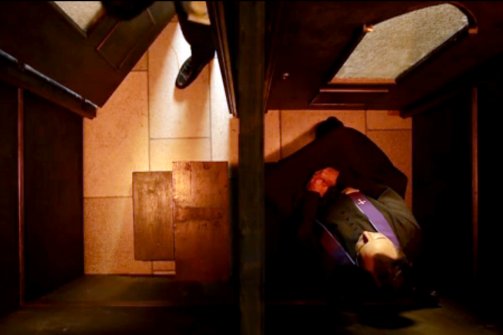‘mea Maxima Culpa’ Reveals What the Catholic Church Knew
Daily Beast
Gibney illustrates the acts of abuse through hazy images and shadowy figures. Flowing cassocks catch the light as a figure meant to be Murphy tiptoes through the boys’ dorm late at night to find a boy to molest while the others lay still in their beds pretending not to notice. At one stage, according to a victim’s recollections, Murphy relocated the confessional at St. John’s from the tiny cabinet to a closet. Gibney illustrates the point with a young boy kneeling in front of a character portraying the priest. But he is not asked to pray. Instead, he is to open the priest’s cassock and perform fellatio. The film contrasts the vile acts with gorgeous visual imagery of Rome, Vatican City, and standard church icons like masterpiece portraits of the Virgin Mary, and Gibney captures so perfectly the rituals many Catholics identify with. It is just after those moments of Catholic comfort when Gibney hits hardest with a shocking scene or recollection from a victim about what was happening behind the altar. Through that quick transition from good to evil, Gibney manages to nail the vulnerability that Catholic guilt creates by exposing the almost Godlike esteem bestowed on the clergy—which is what keeps so many victims from coming forward and which makes so many families skeptical when they finally do. The plight of the vulnerable deaf children, especially, underscores how such a vital trust was betrayed. Mea Maxima Culpa also wags a condemning finger at Pope Benedict XVI, who in his previous capacity as head of the Congregation for the Doctrine of the Faith, would have seen reams of complaints about predator priests pass by his desk. Just how much the church knew is not in doubt for Gibney, who sprinkles in details of how the church quietly worked to combat the problem they had been dealing with for decades, including sending priests to a little-known monastery in New Mexico run by the Servants of the Paraclete, where they supposedly were treated for their sexual deviance before being reassigned to new parishes. And then there is a tale about the Vatican’s down payment to buy a Caribbean Island to house errant clergy—a plan scuttled after the media got wind of it. Insightful narrative from well-known Vatican followers in Rome and religious writers and lawyers in America fill in the gaps, providing analogies and observations about how the church does its business and how, for instance, church handlers had to teach cardinals to mention the victims first when talking about the known crimes, not to talk only about the priests. While the focus of the film is weighted heavily on Father Murphy’s sins, several other recognizable scandals are used to bolster the point that sexual abuse was not an anomaly that happened only in America. Gibney nods to the Irish church’s problems with a glance at Father Tony Walsh, an Elvis impersonator who sang with a group called All-Priests Show and was sentenced to 16 years for horrific sexual abuses, including tying a 7-year-old boy to an altar with a monk’s rope belt and sodomizing him. The film also highlights the case against a Mexican priest, Father Marcial Maciel Degollado, who founded the controversial Legionnaires of Christ and who was highly influential in the Vatican hierarchy because of his group’s impressive financial contributions. Maciel, who died in 2008, was a known pedophile who was accused of sexually abusing up to 20 seminarians. He was also a documented philanderer who fathered several children with various women. He was protected for years by the Vatican’s former secretary of state, Angelo Sodano, who was able to keep Maciel shielded from criminal prosecution as long as the money kept rolling in. (Sodano has disavowed any cover-up; in 2010, he dismissed such allegations as “petty gossip.”) The film also wags a condemning finger at Pope Benedict XVI. The film, produced by HBO Documentary, will be in theaters this fall and on HBO next year. In the meantime, the Vatican is typically silent on the subject. When reached for comment, a Vatican spokesperson told The Daily Beast that no one there had yet seen the film, so it was impossible to say what they really thought of it. Instead, the spokesperson suggested reading a letter written by Father Raymond de Souza in 2010 in response to allegations against Father Murphy reported in The New York Times at the time. The church flatly denies direct responsibility for the decades of alleged abuse. Gibney’s chilling subject matter likely won’t make for a box-office hit. In any case, this is the type of film one watches in the quiet of one's home, with a remote control in hand to pause when the details are just too vile.
|
.
Any original material on these pages is copyright © BishopAccountability.org 2004. Reproduce freely with attribution.
